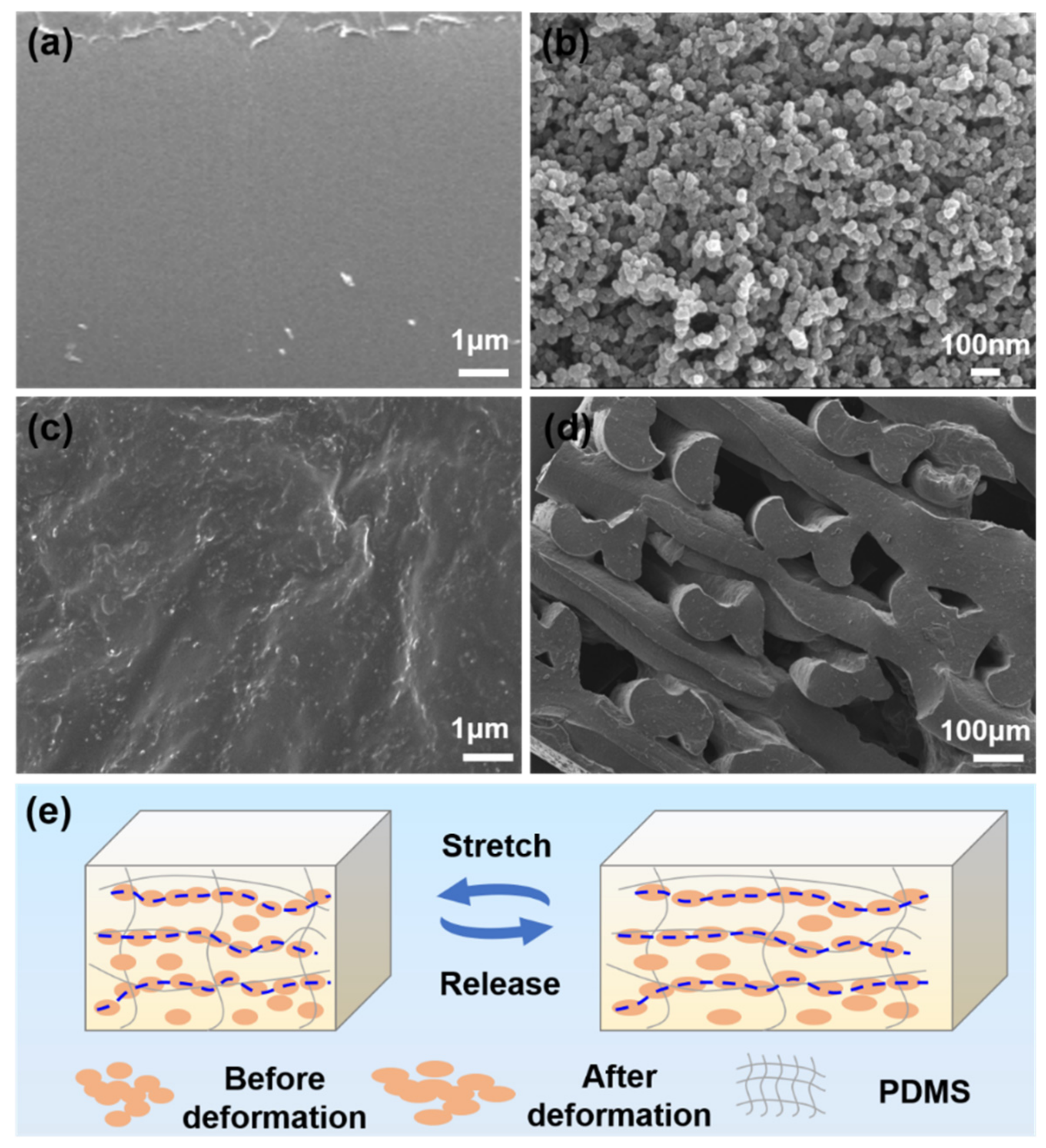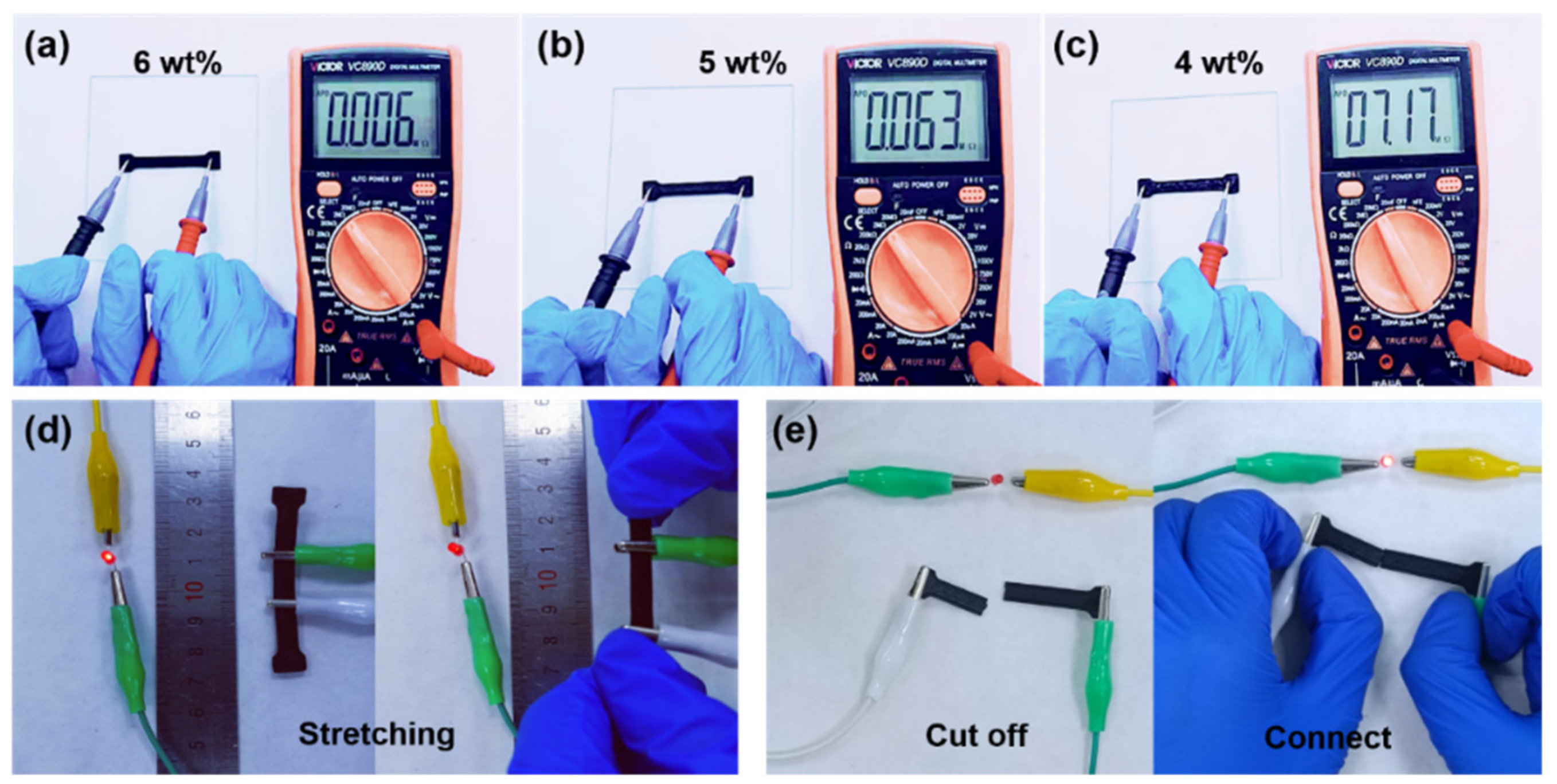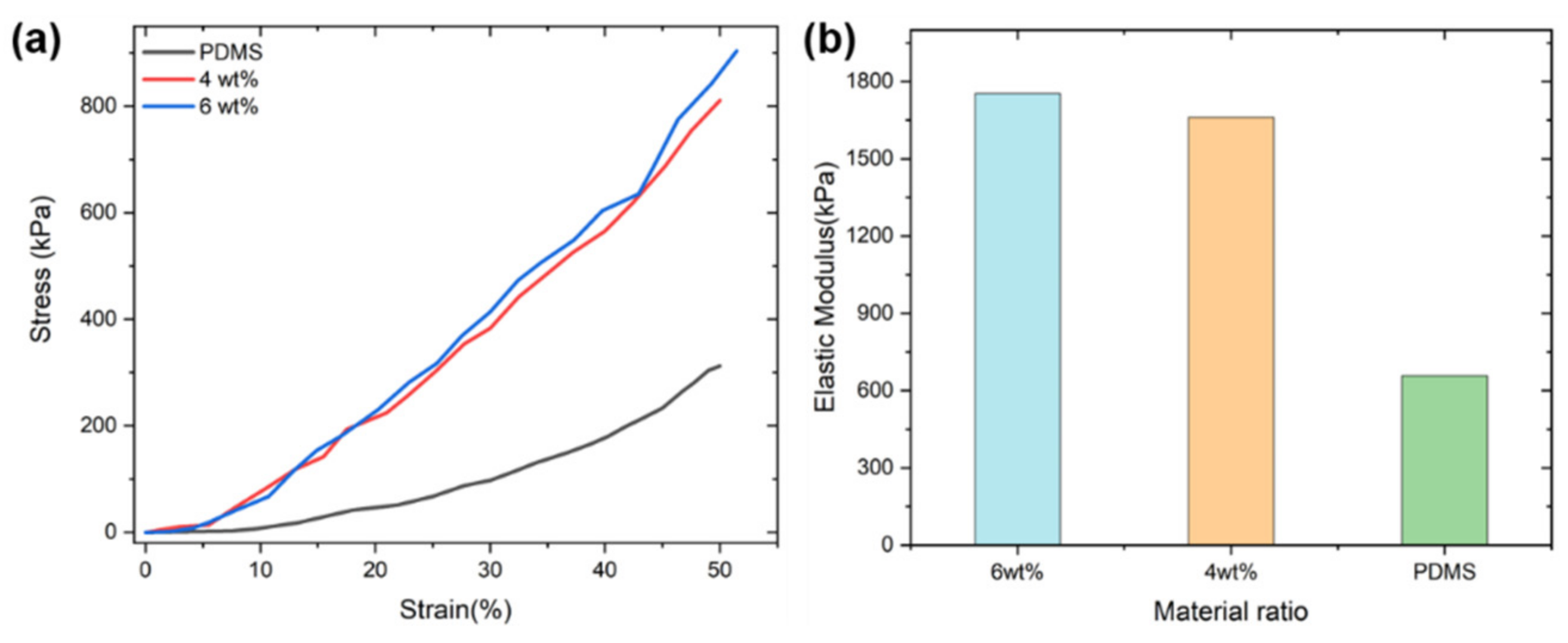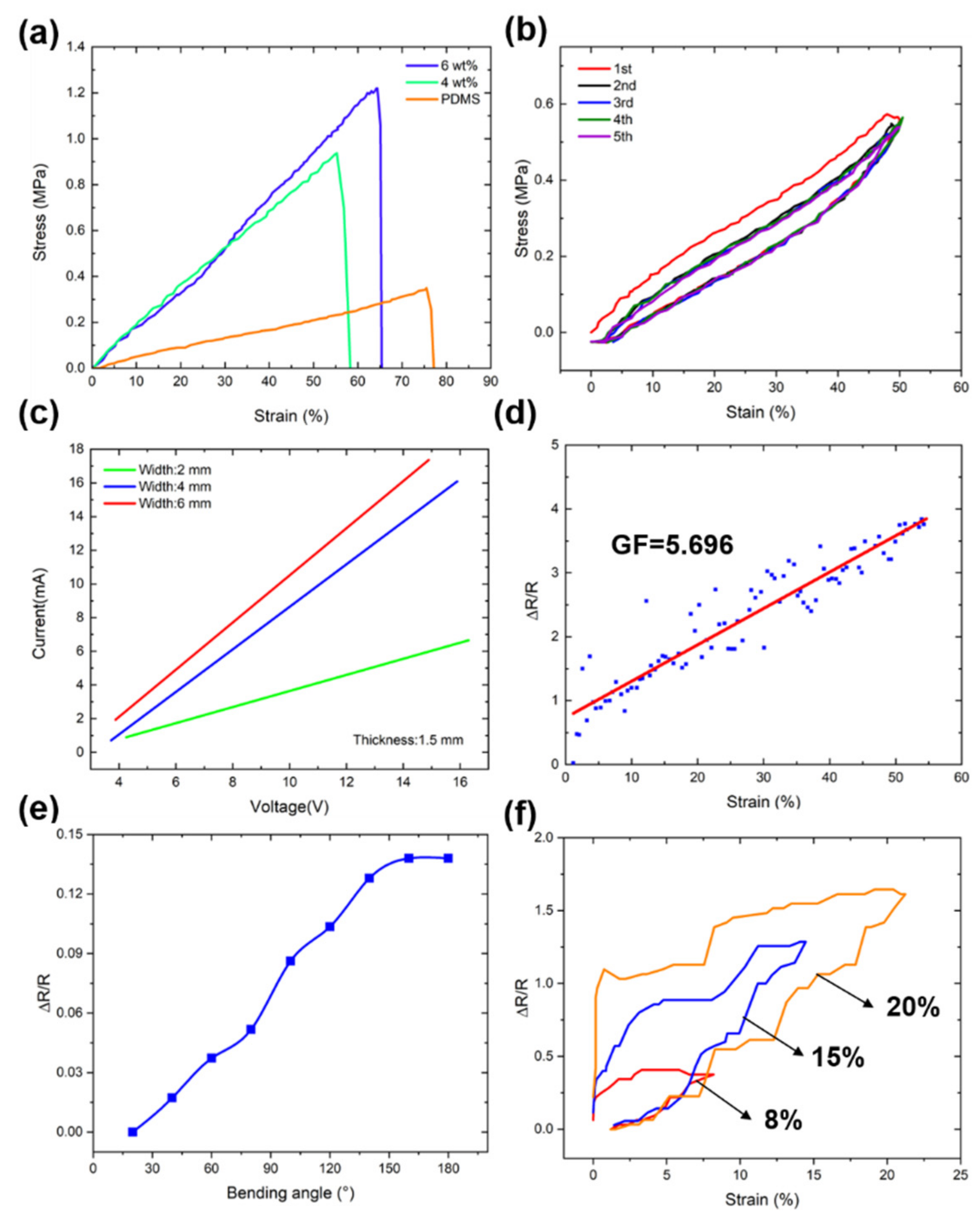Three-Dimensional Printed Carbon Black/PDMS Composite Flexible Strain Sensor for Human Motion Monitoring
Abstract
:1. Introduction
2. Materials and Methods
2.1. Materials
2.2. Preparation of CB/PDMS Conductive Composites
2.3. Three-Dimensional Printed Flexible Strain Sensors
2.4. Characterization and Testing
3. Results
3.1. Three-Dimensional Printed Strain Sensors with CB/PDMS Composites
3.2. Properties of CB/PDMS Composites
3.3. Electromechanical Properties of CB/PDMS Composites
3.4. Application of 3D Printed Flexible Strain Sensor
4. Conclusions
Supplementary Materials
Author Contributions
Funding
Data Availability Statement
Conflicts of Interest
References
- Dubal, D.P.; Chodankar, N.R.; Kim, D.H.; Gomez-Romero, P. Towards flexible solid-state supercapacitors for smart and wearable electronics. Chem. Soc. Rev. 2018, 47, 2065–2129. [Google Scholar] [CrossRef]
- Li, L.; Lou, Z.; Chen, D.; Jiang, K.; Han, W.; Shen, G. Recent advances in flexible/stretchable supercapacitors for wearable electronics. Small 2017, 14, 1702829. [Google Scholar] [CrossRef] [PubMed]
- Kang, J.; Son, D.; Wang, G.N.; Liu, Y.; Lopez, J.; Kim, Y.; Oh, J.Y.; Katsumata, T.; Mun, J.; Lee, Y.; et al. Tough and water-insensitive self-healing elastomer for robust electronic skin. Adv. Mater. 2018, 30, 1706846. [Google Scholar] [CrossRef] [PubMed]
- Donghee, S.; Jiheong, K.; Orestis, V.; Yeongin, K.; Naoji, M.; Young, O.J.; To John, W.F.; Jaewan, M.; Toru, K.; Yuxin, L. An integrated self-healable electronic skin system fabricated via dynamic reconstruction of a nanostructured conducting network. Nat. Nanotechnol. 2018, 13, 1057–1065. [Google Scholar]
- Qiao, Y.; Wang, Y.; Tian, H.; Li, M.; Jian, J.; Wei, Y.; Tian, Y.; Wang, D.Y.; Pang, Y.; Geng, X. Multilayer graphene epidermal electronic skin. ACS Nano 2018, 12, 8839–8846. [Google Scholar] [CrossRef] [PubMed]
- Xiong, Y.; Shen, Y.; Tian, L.; Hu, Y.; Zhu, P.; Sun, R.; Wong, C.-P. A flexible, ultra-highly sensitive and stable capacitive pressure sensor with convex microarrays for motion and health monitoring. Nano Energy 2020, 70, 104436. [Google Scholar] [CrossRef]
- Liu, H.; Zhang, H.; Han, W.; Lin, H.; Li, R.; Zhu, J.; Huang, W. 3d printed flexible strain sensors: From printing to devices and signals. Adv. Mater. 2021, 33, e2004782. [Google Scholar] [CrossRef] [PubMed]
- Jidong, S.; Liu, W.; Zhaohe, D.; Lingyu, Z.; Mingde, D.; Hongbian, L.; Ying, F. Multiscale hierarchical design of a flexible piezoresistive pressure sensor with high sensitivity and wide linearity range. Small 2018, 14, 1800819. [Google Scholar]
- Gao, L.; Zhu, C.; Li, L.; Zhang, C.W.; Huang, W. All paper-based flexible and wearable piezoresistive pressure sensor. ACS Appl. Mater. Interfaces 2019, 11, 25034–25042. [Google Scholar] [CrossRef]
- Pang, Y.; Zhang, K.; Yang, Z.; Jiang, S.; Ju, Z.Y.; Li, Y.; Wang, X.; Wang, D.Y.; Jian, M.; Zhang, Y. Epidermis microstructure inspired graphene pressure sensor with random distributed spinosum for high sensitivity and large linearity. Acs Nano 2018, 12, 2346–2354. [Google Scholar] [CrossRef] [PubMed]
- Dai, X.; Huang, L.B.; Du, Y.; Han, J.; Kong, J. Self-healing flexible strain sensors based on dynamically cross-linked conductive nanocomposites. Compos. Commun. 2021, 24, 100654. [Google Scholar] [CrossRef]
- Gong, X.; Sang, Z.; Guo, H.; Ke, K.; Feke, D.L. Piezoresistive strain sensors based on psyllium-carbon nanostructure skeletons. Compos. Part B Eng. 2021, 209, 108610. [Google Scholar] [CrossRef]
- Acuautla, M.; Bernardini, S.; Gallais, L.; Fiorido, T.; Patout, L.; Bendahan, M. Ozone flexible sensors fabricated by photolithography and laser ablation processes based on zno nanoparticles. Sens. Actuators B Chem. 2014, 203, 602–611. [Google Scholar] [CrossRef]
- Liang, B.; Zhang, Z.; Chen, W.; Lu, D.; Yang, L.; Yang, R.; Zhu, H.; Tang, Z.; Gui, X. Direct patterning of carbon nanotube via stamp contact printing process for stretchable and sensitive sensing devices. Nano-Micro Lett. 2019, 11, 619–629. [Google Scholar] [CrossRef] [Green Version]
- Heo, S.; Ha, J.; Son, S.J.; Choi, I.S.; Lee, H.; Oh, S.; Jekal, J.; Kang, M.H.; Lee, G.J.; Jung, H.H. Instant, multiscale dry transfer printing by atomic diffusion control at heterogeneous interfaces. Sci. Adv. 2021, 7, eabh0040. [Google Scholar] [CrossRef] [PubMed]
- Yang, M.; Cheng, Y.; Yue, Y.; Chen, Y.; Gao, H.; Li, L.; Cai, B.; Liu, W.; Wang, Z.; Guo, H.; et al. High-performance flexible pressure sensor with a self-healing function for tactile feedback. Adv. Sci. 2022, 9, e2200507. [Google Scholar] [CrossRef] [PubMed]
- Rui, C.A.; Tao, L.A.; Da, G.A.; Zheng, S.B.; Wei, Z.A. Facile fabrication of a fast-response flexible temperature sensor via laser reduced graphene oxide for contactless human-machine interface. Carbon 2022, 187, 35–46. [Google Scholar]
- Qian, C.; Xiao, T.; Chen, Y.; Wang, N.; Li, B.; Gao, Y. 3d printed reduced graphene oxide/elastomer resin composite with structural modulated sensitivity for flexible strain sensor. Adv. Eng. Mater. 2021, 24, 2101068. [Google Scholar] [CrossRef]
- Kim, H.-G.; Hajra, S.; Oh, D.; Kim, N.; Kim, H.J. Additive manufacturing of high-performance carbon-composites: An integrated multi-axis pressure and temperature monitoring sensor. Compos. Part B Eng. 2021, 222, 109079. [Google Scholar] [CrossRef]
- Wang, Y.; Willenbacher, N. Phase-change-enabled, rapid, high-resolution direct ink writing of soft silicone. Adv. Mater. 2022, 34, e2109240. [Google Scholar] [CrossRef] [PubMed]
- Hwang, B.U.; Lee, J.H.; Trung, T.Q.; Roh, E.; Kim, D.I.; Kim, S.W.; Lee, N.E. Transparent stretchable self-powered patchable sensor platform with ultrasensitive recognition of human activities. ACS Nano 2015, 9, 8801–8810. [Google Scholar] [CrossRef] [PubMed]
- Amjadi, M.; Yoon, Y.J.; Park, I. Ultra-stretchable and skin-mountable strain sensors using carbon nanotubes-ecoflex nanocomposites. Nanotechnology 2015, 26, 375501. [Google Scholar] [CrossRef] [PubMed]
- Park, J.J.; Hyun, W.J.; Mun, S.C.; Park, Y.T.; Park, O.O. Highly stretchable and wearable graphene strain sensors with controllable sensitivity for human motion monitoring. ACS Appl. Mater. Interfaces 2015, 7, 6317. [Google Scholar] [CrossRef]
- Rahimi, R.; Ochoa, M.; Yu, W.; Ziaie, B. Highly stretchable and sensitive unidirectional strain sensor via laser carbonization. ACS Appl. Mater. Interfaces 2015, 7, 4463–4470. [Google Scholar] [CrossRef] [PubMed]
- Zheng, R.; Chen, Y.; Chi, H.; Qiu, H.; Bai, H. 3d printing of a polydimethylsiloxane/polytetrafluoroethylene composite elastomer and its application in a triboelectric nanogenerator. ACS Appl. Mater. Interfaces 2020, 12, 57441–57449. [Google Scholar] [CrossRef] [PubMed]
- Araromi, O.A.; Rosset, S.; Shea, H.R. High-resolution, large-area fabrication of compliant electrodes via laser ablation for robust, stretchable dielectric elastomer actuators and sensors. ACS Appl. Mater. Interfaces 2015, 7, 18046–18053. [Google Scholar] [CrossRef] [PubMed]
- Chen, X.; Lin, X.; Mo, D.; Xia, X.; Gong, M.; Lian, H.; Luo, Y. High-sensitivity, fast-response flexible pressure sensor for electronic skin using direct writing printing. RSC Adv. 2020, 10, 26188–26196. [Google Scholar] [CrossRef] [PubMed]
- Park, Y.B. Piezoresistive behavior and multi-directional strain sensing ability of carbon nanotube-graphene nanoplatelet hybrid sheets. Smart Mater. Struct. 2012, 22, 015013. [Google Scholar]
- Muth, J.T.; Vogt, D.M.; Truby, R.L.; Mengüç, Y.; Kolesky, D.B.; Wood, R.J.; Lewis, J.A. 3d printing: Embedded 3d printing of strain sensors within highly stretchable elastomers (adv. Mater. 36/2014). Adv. Mater. 2014, 26, 6202. [Google Scholar] [CrossRef]
- Stübler, N.; Fritzsche, J.; Klüppel, M. Mechanical and electrical analysis of carbon black networking in elastomers under strain. Polym. Eng. Sci. 2011, 51, 1206–1217. [Google Scholar] [CrossRef]






Publisher’s Note: MDPI stays neutral with regard to jurisdictional claims in published maps and institutional affiliations. |
© 2022 by the authors. Licensee MDPI, Basel, Switzerland. This article is an open access article distributed under the terms and conditions of the Creative Commons Attribution (CC BY) license (https://creativecommons.org/licenses/by/4.0/).
Share and Cite
Lian, H.; Xue, M.; Ma, K.; Mo, D.; Wang, L.; Cui, Z.; Chen, X. Three-Dimensional Printed Carbon Black/PDMS Composite Flexible Strain Sensor for Human Motion Monitoring. Micromachines 2022, 13, 1247. https://doi.org/10.3390/mi13081247
Lian H, Xue M, Ma K, Mo D, Wang L, Cui Z, Chen X. Three-Dimensional Printed Carbon Black/PDMS Composite Flexible Strain Sensor for Human Motion Monitoring. Micromachines. 2022; 13(8):1247. https://doi.org/10.3390/mi13081247
Chicago/Turabian StyleLian, Haishan, Ming Xue, Kanglin Ma, Deyun Mo, Lei Wang, Zaifu Cui, and Xiaojun Chen. 2022. "Three-Dimensional Printed Carbon Black/PDMS Composite Flexible Strain Sensor for Human Motion Monitoring" Micromachines 13, no. 8: 1247. https://doi.org/10.3390/mi13081247
APA StyleLian, H., Xue, M., Ma, K., Mo, D., Wang, L., Cui, Z., & Chen, X. (2022). Three-Dimensional Printed Carbon Black/PDMS Composite Flexible Strain Sensor for Human Motion Monitoring. Micromachines, 13(8), 1247. https://doi.org/10.3390/mi13081247






